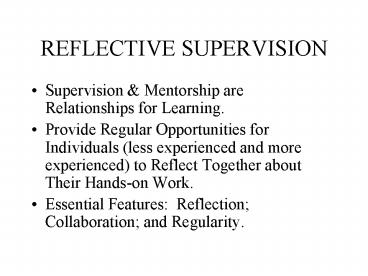REFLECTIVE SUPERVISION - PowerPoint PPT Presentation
1 / 22
Title:
REFLECTIVE SUPERVISION
Description:
Provide Regular Opportunities for Individuals (less experienced and more ... Keep the focus on the dyadic (pair) interaction. Raise possibilities rather than dictates. ... – PowerPoint PPT presentation
Number of Views:734
Avg rating:3.0/5.0
Title: REFLECTIVE SUPERVISION
1
REFLECTIVE SUPERVISION
- Supervision Mentorship are Relationships for
Learning. - Provide Regular Opportunities for Individuals
(less experienced and more experienced) to
Reflect Together about Their Hands-on Work. - Essential Features Reflection Collaboration
and Regularity.
2
Introduction Donna Davidovitz
3
Regularity
- Must Occur Regularly.
- Time Must Be Allocated for These Relationships,
and the Time Must Be Protected. - It Takes Time to Reflect, Time to Collaborate,
and Above All Time To Establish Trust in the
Reliable Nature of the Relationship Itself.
4
Collaboration
- Shared Power, Clear Mutual Expectations, and Open
Communication. - Power derives from Knowledge, not just Experience
or Conviction. - Power can be held Mutually Without being Shared
Equally. - The Process of Reflection Encourages Ongoing
Self-Evaluation. - Formal Evaluations Become Occasions for a
Systematic Review of What Have Been Continuing
Conversations.
5
Collaborative Relationship
- Clear Mutual Expectations Roles
Responsibilities Must Be Established. - Participants Need to Agree on the Logistics of
Their Arrangement When Where They Will Meet.
- Must Agree on the Content They Will Look At
Together Might Include On-the-Job
Performance, Directly Observed Written Notes of
Interactions with Children Families an Oral
Account of Experience or Reflection on
Supervisory Relationship Itself. - Need a Clear Mutual Understanding about the
Nature of the Relationship Boundaries
Distinctions between Supervision Friendship,
and Supervision Therapy.
6
Relationships are Central in Reflective
Supervision
7
Features Regularity, Safe, Collaborative,
Reflective
8
Why Promote Reflective Supervision?Benefits
- Models a mutually respectful, collaborative
approach to monitoring performance maintaining
an acceptable level of service. - Models a mutually respectful, collaborative
relationship that parallels the supervisee/family
relationship - Creates Maintains an overall climate of
intellectual inquiry, open communication, empathy
with staff concerns, and support for the
long-term professional development of staff.
9
Supervision/Mentorship
- Essential for Delivery of High Quality Services.
- WICAPs Mission Helping People Help Themselves
compliments Reflective Supervision. - WICAP Head Start R Time Practice Recognizes
Builds on Capacities, Resilience,
Resourcefulness. - Reflection Golden Rule Do unto others as you
would have them do unto others.
10
Facilitate Communication
- Supports individual practitioners, particularly
as they deal with the stressful aspects of work
with infants, toddlers and their families. - Shape Questions with which to Probe and Ponder
Their Behavior, Beliefs, and Values, as well as
reflect on WICAP Head Starts Program
Philosophies, Mission, and Service Delivery. - Provide a Relationship and an Environment in
which the Professional Identity can Emerge
Gradually, until what once seemed Tacked on
Becomes a Core Part of the Employees Sense of
Self. - Encourage Thoughtful, Open Communication in Daily
Activities. - Communication Flows Freely in Both Directions.
11
R Time Provides Opportunities
- To Deepen and Broaden Knowledge
- Reflect regularly, in a safe environment, on the
full range of reactions to the experience of
practice - Discuss individual goals and measure progress
toward them - Develop refine ones professional use of self
and individual style, through increased
self-understanding.
12
The Importance of Open Communication that
Provides Staff Support
13
Guidelines to Engage in Effective Dialogue
- Show up and be fully present
- Pay close attention
- Tell the truth
- Be open to a variety of outcomes, not attached to
particular outcomes - Be committed to creating a shared understanding
and a shared learning.
14
The Importance of the Supervisor Modeling Ways to
Problem Solve, Think, Connect With the Families
15
Reflective Supervision
- Both parties (supervisor supervisee) need to
commit to the R Time process - Supervisor introduces R Time as an opportunity
to think and talk about service delivery. - It is a safe environment to communicate
- Allows them to expand their own problem solving
skills - Encourages Professional Development.
16
Relationship Based Early Intervention Work
Builds Staff Parent Alliances
17
The Reflective Supervisors Role
18
Thinking about Reflective Supervision Techniques
- HOW TO BE
- Be aware of your own feelings
- Strike a balance
- Provide a safe empathetic environment
- Help determine boundaries
- Reflect on hesitations
- Resist the urge to take over and tell staff what
to do - Remember and use information from past sessions
- Maintain boundaries (time regularity).
19
Thinking about Reflective Supervision Techniques
- HOW TO UNDERSTAND
- Listen very carefully
- Use open-ended questions
- Raise questions about counter-transference
- Raise questions about boundary issues
- Use questions to reframe
- Try to imagine the experience
- Take time for clarification.
20
Thinking about Reflective Supervision Techniques
- HOW TO INFLUENCE
- Address issues of concern directly
- Model language
- Set up mini-role plays to practice language
- Label issues (role conflicts, ambiguity, etc.)
- Participate in collaborative problem solving
- Use observations over time
- Keep the focus on the dyadic (pair) interaction.
- Raise possibilities rather than dictates.
- Ask questions (why they did not address an issue?
- What they would redo?)
21
-WICAP Head Start Reflective Supervision Process
- Review Established R TIME SCHEDULE
- Schedule Reflective Time with staff you
supervise. - HS-502 WICAP HEAD START R TIME SUPERVISION FORM
- Process Copy form (R Time participant
schedule) for each individual you supervise (that
documents times you met) and submit copy of form
to your supervisor along with your month-end
report.
22
Training Sources
- Fenichel, E., (n.d). Zero to Three/National
Center for Clinical Infant Programs Work Group
on Supervision and Mentorship. Learning through
Supervision and Mentorship To Support the
Development of Infants, Toddlers and Their
Families, 1-9. - Davidovitz, D. (November 4-5, 2002). Lecture
Understanding and Implementing Reflective
Supervision.































